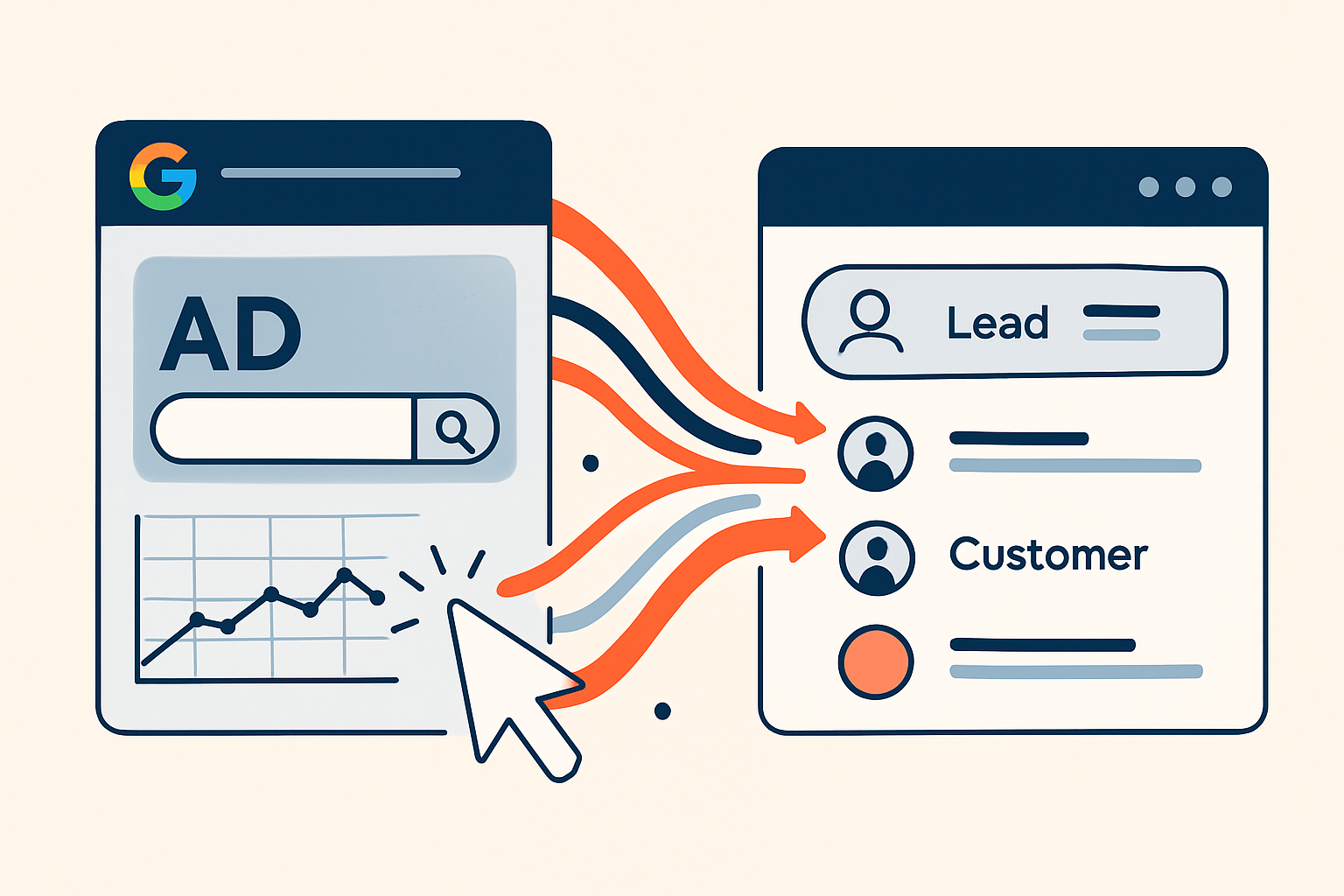Why Integration Matters
Running great Google Ads campaigns is only half the job — the real challenge begins when leads come in. Too often, ad data stays trapped in Google while sales teams work separately in a CRM, leaving valuable insights untapped.
By connecting Google Ads and HubSpot CRM, you create a closed feedback loop: marketing sees what happens after a click, and sales gets real-time data on where each lead originated. The result? Better targeting, cleaner data, and more revenue from every dollar spent.
1. Visibility From Click to Close
With the integration, you can track every lead from the moment they click an ad to the moment they become a customer.
Key benefits:
- Attribute revenue directly to the campaigns, keywords, and ads that actually convert.
- Identify which channels and audiences deliver the highest-quality leads.
- Give marketing and sales teams shared insight into ROI.
Instead of guessing which campaigns perform best, HubSpot's reporting makes it clear where to double down — and where to cut spend.
2. Smarter Lead Qualification
Every lead captured through a HubSpot form, landing page, or call tracked via Google Ads automatically flows into the CRM — with all the context intact.
Why it matters:
- Ad source, keyword, and campaign data sync directly to contact records.
- Lead scoring can factor in engagement and ad intent, not just form fills.
- Sales can prioritize high-value leads faster with automated notifications.
This means no more manual exports or missing context — just qualified leads ready for follow-up.
3. Better Targeting With Real Conversion Data
When Google Ads and HubSpot CRM share data, your campaigns become smarter over time.
Here's how:
- Sync lifecycle stage and deal data from HubSpot back to Google.
- Build lookalike audiences based on actual closed-won customers.
- Exclude existing customers or disqualified leads to avoid wasted spend.
You're not just optimizing for clicks anymore — you're optimizing for revenue.
4. Closed-Loop Reporting That Proves ROI
Marketing teams often struggle to prove the real business impact of ads. HubSpot solves that by connecting advertising metrics to sales outcomes.
With closed-loop reporting, you can:
- See exactly how many customers (not just leads) came from paid campaigns.
- Measure cost per customer, not just cost per lead.
- Align ad budgets with true ROI instead of vanity metrics.
It gives leadership clear visibility into what's working — and what's not — without exporting data between tools.
5. Streamlined Lead Nurturing and Automation
Once a lead enters HubSpot, automation takes over.
You can:
- Trigger nurture workflows based on ad source or keyword intent.
- Automatically assign leads to sales reps by region, service, or campaign type.
- Send tailored follow-ups and email sequences aligned to buyer stage.
It transforms Google Ads from a one-time touchpoint into the start of a connected customer journey.
6. Data Hygiene and Unified Tracking
Disjointed tools create duplicate records, inconsistent tracking, and unclear attribution. Integrating Google Ads with HubSpot ensures data hygiene stays intact.
Benefits include:
- Consistent tracking IDs and contact records across systems.
- Automatic syncing of new and updated leads.
- Centralized reporting that eliminates manual data cleanup.
This integration isn't just about generating leads — it's about maintaining clean, reliable insights your teams can trust.
7. AI and Predictive Insights
HubSpot's AI-powered tools enhance lead generation even further.
With AI in play, you can:
- Predict which ad-sourced leads are most likely to close.
- Personalize messaging based on prior engagement and CRM data.
- Use AI assistants to create ad copy, emails, and follow-ups faster.
The result is a smarter, faster, and more efficient lead-gen system that learns and improves with every campaign.
8. One Source of Truth for Marketing and Sales
When both teams operate from the same system, alignment becomes automatic. Marketing can see what happens after the lead is handed over, and sales can track which campaigns fill the pipeline.
This shared visibility builds accountability — and eliminates the "black hole" where leads used to disappear.
When to Integrate Google Ads and HubSpot
This setup is ideal if:
- You run lead-generation campaigns with forms, calls, or gated content.
- You struggle to track which ads generate customers (not just leads).
- Your marketing and sales teams use separate tools or data sources.
- You're scaling and need clearer ROI tracking before increasing budget.
Even small-to-mid-size businesses benefit from the integration — it's fast to set up and creates instant clarity on performance.
The Bottom Line
Connecting Google Ads with HubSpot CRM transforms your marketing from guesswork into a measurable, repeatable growth system.
You'll know where your best customers come from, spend smarter, and turn ad clicks into long-term relationships — not just form submissions.
Get more from your ad spend. Talk to our team about integrating Google Ads and HubSpot for smarter lead generation.
